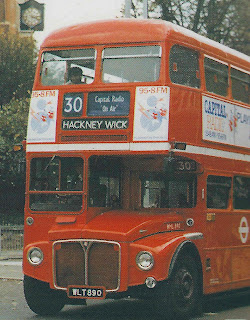Route 26 (Hackney Wick - Waterloo) is the direct descendant of the eastern end of route 6 - the creation of the 1992 scheme to sever cross-London trunk routes for reliability reasons and to concentrate them in areas from which they could be more easily be tendered. Until then these routes were often run by two or three garages on opposite sides of London.
Route 30 (Hackney Wick - Marble Arch) has a very much longer lineage and has grown shorter - its western terminus retreating from Roehampton, Putney, West Brompton, Trafalgar Square and to Marble Arch over the past 30 years.
There has been considerable competition in east London for bus route contracts over the past few years and after considerable incursions by Ensignbus, Capital Citybus and subsequently First London East in the period from 1986 quite a bit of that market share has been lost as a result of the arrival of Go-Ahead in this area and the aggressive contract bidding policies of the former owners of East London Bus Group (who of course made the bids for which the results have just been announced).
Good news for the taxpayers of London, of course, holding contract prices down.
Now, the tide has turned just a little and as capacity has become available in depots opportunities to make competitive bids has enabled First to win three key trunk services in Central London and all now scheduled for commencement in June 2011.
The London contracting system has grown from being employed for isolated routes with poor cost recovery performance, to the entire bus network. The basic formula has delivered against a requirement for no subsidy and the availability of significant sums. It was weathered net and gross cost contracting regimes, incentivisation, several economic cycles and control by central and local Government. Not a bad record for the mechanism originally created inside the London Transport of the mid 1980s.
In 1986 Jim Blake captured RML890 on route 30. Passengers on this bus were all listening to Capital Radio being broadcast to both saloons. It was advertised on bus sides, on the destination blind, and of course passed their HQ and studios at Euston towers.
.....

Excellent news for First. However, one wonders if this is a shrewd move by Stagecoach to reduce the PVR sufficiently to hand back to TfL the very expensive rented West Ham premises and concentrate the Stagecoach operations in the "owned" garages, as part of the recovery plan? Or am I being cynical? Mark H
ReplyDeleteMark - presumably the tenders for these two services were submitted by ELBG long before the stagecoach purchase, so I wouldn't be rushing to draw any conclusions about Stagecoach's strategy just yet.
ReplyDeleteAnd if I had seen that blind I would have avoided the bus like the plague!
ReplyDeleteYes, I mean it, but more specifically (and less self-indulgently) is there any info as to how effective the intiative turned out to be? I don't recall the system to have had a long life.
Peter